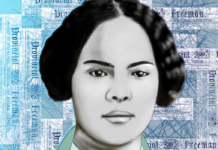To say Generation Z has experienced one of the more interesting educational journeys of any American generation is likely an understatement. From a global pandemic to growing attacks on what is being taught in the classrooms to the most diverse generation of students that our nation has ever seen.
During the ongoing pandemic, Gen Z students have had to navigate an educational experience that saw us switching to full-time distance learning, addressing barriers caused by a lack of necessary technology, and living in a world where most of us lost contact with our social circles and natural peer support groups.
Black and Latino students, already lagging behind in student success and outcomes before COVID-19, saw our peers struggling to keep up with our grade level studies.
This pandemic has also introduced us to a discussion about learning loss. Black and Latino students, already lagging behind in student success and outcomes before COVID-19, saw our peers struggling to keep up with our grade level studies.
A report by McKinsey demonstrated that “learning loss was especially acute in schools that predominantly serve students of color, where scores were 59% of the historical average in math and 77% in reading”.
Much of the national, state and local discussions by educators and policymakers have been focused on the legitimate concern over learning loss. And if that wasn’t enough for Gen Z students, coming back to in-person learning has been met with adults fighting over mask mandates and warped understanding of critical race theory.
Our most vulnerable and historically disriminated student populations have always struggled to achieve academic success.
Yet, as much as we are caught in this cycle of COVID-19 and CRT, we are also very aware that the disparities in our educational opportunities were there before these recent events. There has been an overwhelming number of reports and data collected that demonstrated that our most vulnerable and historically discriminated student populations have always struggled to achieve academic success.
Black Students Have Always Faced Serious Barriers to Educational Equity
Black students have always faced serious barriers to equity in our schools. A National School Boards Association (NSBA) report in 2020 highlighted the issues. A high number of Black students lived in poverty compared to other demographic groups. As access to the internet becomes more crucial to academic opportunity and success, 10% of Black students in 2018 lacked home internet access. Black students continued to be grouped into school sites with an overall high-poverty rate. Dropout rates for Black students continued to be higher than other students.
At the opposite end of the academic spectrum, even when Black students were doing well, they were still denied educational opportunities. In 2020, Education Trust published data that demonstrated that Black students represent 16% of elementary school enrollment, but only 9% of the students in our nation’s gifted and talented program. Black students make up approximately 15% of our nation’s high school students, but only 9% of those high school students enrolled in at least one advanced placement course.
Buried in this data was also a reminder that our nation continues to be disconnected between the diverse student population that makes up our schools across the nation and the diversity of our nation’s teacher workforce. The NSBA report data demonstrated that only 7% of our public school teachers were Black.
Does Having a Black Teacher Really Matter?
A study by John Hopkins University and American University published in 2018 found that a Black student that has one Black teacher by third grade was 13% more likely to graduate from high school and enroll in college. If they have two Black teachers they are 32% more likely to enroll in college.
So, the data is there. Honestly, it has been there for a long time. The issue for Gen Z is one where we wonder why it is taking policymakers, education leaders, communities, and our nation so long to act on it.
Recently the Center for Black Educator Development launched a new public campaign to bring attention to the issue of the importance of Black teachers. Their We Need Black Teachers campaign is groundbreaking because it moves us from a discussion of the problem to engagement on solutions. They highlight that we need 280,000 new Black teachers to meet the needs of our schools.
Additionally, they go a step further and directly engage Gen Z on why becoming a teacher is so important for the future of our communities. They openly embrace that “Black teachers fight racism through education” and that “teaching is an act of revolution”. If anyone doubts if this empowerment mindset and messaging is needed, the news coming out of Southlake, Texas should end that.
It seems some states are finally paying attention and taking action in an attempt to increase teacher workforce diversity. In California legislation authored by Assemblyman Mike Gipson, and supported by California State Superintendent of Public Instruction Tony Thurmond, was signed into law by Governor Newsom creates the Teacher Workforce Grant Program, providing $15 million to recruit and retain male teachers of color.
In other states, the Grow Your Own movement is starting to make progress. Grow Your Own programs have been recently passed into law in Arkansas, Colorado, Kentucky, Minnesota, Montana, New Jersey, New Mexico, Oregon and Utah. This type of deliberate engagement by states will be necessary if we truly want to turn the desire of creating diverse teachers into reality.
Barriers for Diverse Teacher Recruitment
But these programs are really only a first step towards a solution. An Economist Intelligence Unit survey, commissioned by Microsoft, focused on Generation Z members who are already early in their teaching career or entering the student teaching programs. Although it was a global survey, it found that 45% of respondents said salary, stress, and burnout were the primary reasons that would deter them from entering the teaching profession. Sixty-eight percent of survey participants from the United States said that salary was the primary factor keeping young people from entering the teaching profession.
The reality for many students is that the financial burden of paying for their higher education makes pursuing a career as a teacher difficult at times.
For Gen Z members in the United States, the reality for many students is that the financial burden of paying for their higher education makes pursuing a career as a teacher difficult at times. This is especially true for many diverse students. A 2020 survey by Handshake found that “an overwhelming 61% of college students would take a job they’re not passionate about due to the pressure to pay off their student loans.” It also found that 61% of students surveyed admitted “to feeling pressured to choose a major that will result in a high-paying job.”
When you add in the historical racial wealth gap and that Black students are more likely to pay for their college education through debt, we see how this becomes a major barrier to successfully recruiting the diverse students we need for our teacher training programs. Brookings Institute found in their research that “four years after graduation the average Black college graduate owes $52,726, compared to $28,006 for the average white college graduate.” This is a real barrier that will require policymakers, education leaders, and communities to commit to lowering the costs of higher education, student loan forgiveness, and providing competitive compensation for teachers if we want to be successful.
For far too long we have heard about pipelines, but now is the time to build programming pumps that deliberately recruit and support diverse candidates into teaching careers.
If we truly care about addressing the lack of teacher diversity in our nation’s schools, the federal government, states, and school districts will have to embrace and expand these recruitment and retention programs. For far too long we have heard about pipelines, but now is the time to build programming pumps that deliberately recruit and support diverse candidates into teaching careers.










